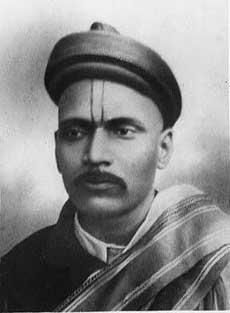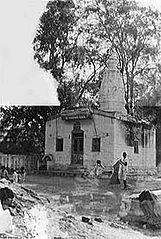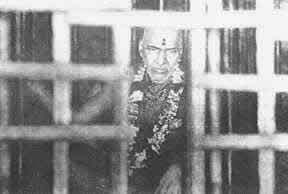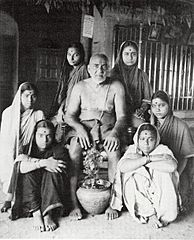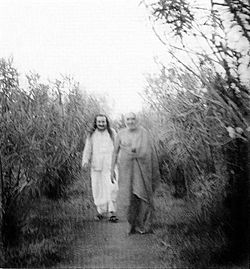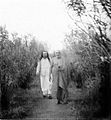Upasani Maharaj facts for kids
Quick facts for kids
Upasani
|
|
|---|---|
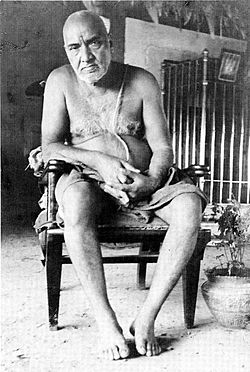 |
|
| Born | 15 May 1870 Satana
|
| Died | 24 December 1941 (aged 71) Ahmednagar district, British India
|
| Era | 20th century |
| Region | India |
| School | Hinduism, Advaita Vedanta |
|
Influences
|
|
|
Influenced
|
|
Upasani Maharaj, born Kashinath Govindrao Upasni, was an important Indian spiritual teacher. Many of his followers believed he was a satguru, which means a true spiritual guide. He lived from May 15, 1870, to December 24, 1941.
Upasani Maharaj lived in a place called Sakori, in what was then British India. People say he achieved a special spiritual state called God-realization with help from Sai Baba of Shirdi. Interestingly, Upasani Maharaj was also a main spiritual teacher for another famous spiritual leader, Meher Baba.
Contents
Early Life and Learning
Kashinath Govind Upasani Shastri, who later became known as Upasani Baba Maharaj, was born into a traditional Brahmin family. This was in the village of Satana, India, on May 15, 1870. He was the second child of Govind Shastri and Rukmina. His father worked in law, and Kashinath was raised by his grandfather and uncle.
Kashinath was very close to his grandfather, Gopala Shastri. Gopala was a wise Sanskrit scholar and lived a simple, spiritual life. He used to advise the Maharaja of Baroda on religious matters. However, when the Maharaja died, the family became poor.
Kashinath started his traditional Brahmin education at age five. At eight, he had his Upanayana ceremony, a special Hindu ritual. He went to a local school but did not like the modern lessons. He left after three years, preferring stories about the power of mantra (sacred words) and tapas (spiritual practices) from ancient texts like the Mahabharata.
Spiritual Journey Begins
Kashinath was deeply influenced by his grandfather's simple lifestyle. He practiced spiritual exercises with great focus, even in a nearby cremation ground. His parents worried about his extreme dedication. They felt he was a burden. Kashinath thought about leaving home to live as a wandering holy man. However, his family arranged for him to marry an eight-year-old girl named Durga when he was fourteen. Sadly, she died within two years.
His parents insisted he stay home and arranged a second marriage. He was sixteen, and his new wife was nine. Kashinath started spending more and more time away from home. When he was home, he studied Ayurvedic medicine. Eventually, he left his family, saying he needed to find work. He went to Pune but struggled to find a job because he lacked formal education. He had to do simple jobs or beg to survive.
A Powerful Spiritual Experience
When he was nineteen, Kashinath returned towards his hometown, hoping to see his grandfather. On his journey, he found a small cave high up a cliff. He decided this was a perfect place to fast until death, hoping to connect with Brahman (the ultimate reality). He stayed in the cave, fasting and repeating sacred words for days.
Over several weeks, he experienced deep spiritual states, leading to a profound samadhi (a state of deep meditation). This powerful experience gave him new hope. He left the cave, very weak, and was helped by a local tribe. He lived with them for a month, helping them sell wood. Then, he continued his journey and reached Satana on July 22, 1890.
Becoming a Physician
Kashinath returned home as a tapavin, someone who had completed intense spiritual practices. He went back to his normal life and continued studying Ayurveda to help his grandfather, who was ill. A month later, his father died from cholera. A year after that, his grandfather passed away, leaving the family poor and in debt. For a year, a famous leader named Bal Gangadhar Tilak supported the family. During this time, in 1891, Kashinath's second wife also died after childbirth.
Six months later, Kashinath married for a third time. This time, his wife was a good match for him. The deaths and debts made him realize he needed to act. He went to Sangli to study Ayurvedic medicine and Sanskrit. After three years, he opened a clinic in Amaravati near Nagpur. He also edited a Marathi Ayurvedic magazine. His business grew, and he became a well-known Ayurvedic doctor. He looked like a successful professional, even wearing a mark of Lord Vishnu on his forehead. When he was twenty-nine, his son was born, but the baby died within a few months.
Challenges and Pilgrimage
Even with success, Kashinath wanted to pay off debts and restore his family's wealth. He moved to Gwalior in 1906, hoping to farm uncultivated land. He invested a lot of money and bought hundreds of acres. However, this was a mistake. The land was difficult to farm, and tenants wouldn't pay. Within two years, he lost his land, money, and reputation. His health also suffered.
Bankrupt, he returned to Amaravati in 1908 to restart his medical practice. But he was disappointed and had lost interest. He eventually closed his clinic. In April 1910, he and his wife began a pilgrimage to visit holy places.
A Health Crisis
During their travels, Kashinath and his wife visited several temples, including Somnath Temple and Omkareshwar Temple. At Omkareshwar, Kashinath meditated intensely. One day, his wife found him unconscious. He woke up, but his breathing was very difficult. He could only breathe by consciously moving his stomach and was constantly gasping.
His wife took him to Nagpur for treatment, but nothing helped. He moved to Dhulia to stay with his brother. The breathing problem became so painful that he desperately searched for a yogi who could cure him. In April 1911, he visited a yogi named Kulkarni Maharaj. This yogi could only give him massages and baths, which did not cure him. Kulkarni Maharaj suggested he visit Sai Baba of Shirdi.
Overcoming Prejudice
Kashinath did not like this advice. He was a respected Brahmin and had followed Hindu traditions. The idea of visiting a Muslim saint was strange to him. Instead, he went to Bombay to see Narayan Maharaj, a Brahmin holy man. When Kashinath met Narayan Maharaj in June 1911, the saint made some puzzling remarks and said they didn't need to meet again.
Frustrated, Kashinath returned to Kulkarni Maharaj, who again urged him to meet Sai Baba. Kulkarni Maharaj explained that Sai Baba was beyond religious differences. This time, Kashinath put aside his doubts and decided to go to Shirdi. Before leaving, he followed an old doctor's advice to drink only hot water. This helped his breathing, and he continued this practice for the rest of his life.
Meeting Sai Baba of Shirdi
Sai Baba was a Muslim faqir who lived in Shirdi, a small farming village. He was known for bringing Hindus and Muslims together. He didn't give long speeches but told stories and parables. His spiritual presence was very strong.
Kashinath arrived in Shirdi in late June 1911. He spoke to local Hindus who praised Sai Baba, but Kashinath still found it hard to accept a Muslim saint. He quickly left to visit a Hindu guru, who, to his surprise, told him to go back to Shirdi. After a week, he returned. He attended the daily Arti ceremonies and continued his spiritual practices.
One day, Sai Baba told his followers that Kashinath needed to stay in Shirdi for four years. He also said that he and Kashinath were the same. Sai Baba asked Kashinath to sit quietly in the nearby, old Khandoba temple. His meditation was not to be based on traditional yoga but on connecting with Sai Baba.
Kashinath followed these instructions for over a year. He ate and drank very little and did no outdoor exercise, except for arti. The small temple was dark and dirty, filled with scorpions and snakes. Yet, in these conditions, he experienced intense spiritual states.
Eventually, Kashinath left the temple and began doing hard physical labor. He worked alone, crushing sugarcane, drawing water, plowing fields, and breaking stones. He had been silent in the temple, but now he began to speak. His moods seemed unpredictable to those around him.
In 1913, during Guru Purnima, Sai Baba told some people to worship Kashinath. Kashinath didn't like the attention, but he allowed it because it was Sai Baba's order. From this time on, Kashinath Govind Upasani Shastri became known as Sri Upasani (Baba) Maharaj.
Life After Shirdi
After three years in Shirdi, Upasani left secretly for Sindi, near Nagpur. Then he went to Nagpur. His food intake increased, causing severe health issues. He had an operation without any pain medicine, as he requested. After recovering, he went to Kharagpur.
For the first four months, he remained unknown. But gradually, his fame grew. He gained many Brahmin followers but focused on helping the bhang caste, who were street sweepers. He chose to live among these "untouchables" in poor conditions. His willingness to live like a sweeper was remarkable, bridging the gap between castes. This was very different from a typical guru's life and his own high-caste background.
Upasani's moods remained unpredictable. He continued to do hard physical work. He cleaned roads, gutters, and toilets, and stayed with people from the lowest castes. He would rest by a dustbin, sometimes bathe in dirty water and drink it. He would even eat dung as if it were fine food. Sometimes he wore a simple gunny sack, which became a symbol for him.
During this time, hundreds of people came to him for his Darshan (a spiritual viewing), worship, and advice. Many religious festivals were celebrated under his guidance. Then, in 1915, he suddenly left Kharagpur and returned to Shirdi.
Upasani Maharaj became known as Sai Baba's spiritual successor. His fame spread, but some of Sai Baba's followers became jealous. Upasani was forced to leave Shirdi for another operation. After recovering, he chose not to return to Shirdi right away. He traveled around India, giving spiritual talks. When the tension eased, he returned to Shirdi and lived again at the Khandoba temple.
Sakori Ashram and Teachings
In 1917, farmers from Sakori, a village near Shirdi, invited Upasani to live with them. They built a hut for him near the cremation ground. Sakori became a permanent spiritual center, or ashram, for Upasani Maharaj. This helped calm the jealousy of those who doubted his role as Sai Baba's heir.
At Sakori, Upasani Maharaj lived a simple life. He did not wear the special robes of a sannyasin (a renunciate) but preferred common gunny cloth. He was not part of any religious group and remained independent. His behavior towards people was often unpredictable, but his spiritual talks were consistent and unique. Many of these talks were written down in the 1920s.
The Bamboo Cage
In 1922, Upasani built a bamboo cage for himself with no exit. The cage was barely big enough for him to lie down. He ate (mostly simple bread and chutney) and bathed inside this small space. His followers kept the cage clean and helped him from outside. Daily Arti ceremonies were performed for him, followed by devotional songs sung by young women who became his kanyas (nuns).
He stayed in the cage for over 14 months. Eventually, he asked his followers to make a door, and he began to come out for short periods. A year later, he stayed outside for longer times. Upasani said he confined himself to teach his followers about service. He wanted them to serve the ashram's garden, temple, or animals, rather than serving him personally.
During this time, Upasani began giving daily spiritual talks that lasted for hours. These talks, given both from inside and outside the cage for nearly five years, attracted followers from far away. His life story, written by Madhav Nath, made him even more famous. In 1923, his talks began appearing in a Marathi magazine and were later published as books. This increased his popularity, and new buildings were built at the Sakori ashram.
Meeting Mahatma Gandhi
Upasani's influence grew across India. He had a big impact on Hindu culture and even on political leaders. Mahatma Gandhi read a new book about Upasani and later visited Sakori. In most Hindu ashrams, Gandhi would have been welcomed as a great guest. But Upasani showed annoyance and used harsh words towards him. Upasani was wearing his simple gunny cloth when Gandhi arrived.
At that time, Gandhi still supported the caste system. He believed that avoiding marriage and dining between different castes was important for spiritual growth. However, after more experiences, Gandhi changed his mind in 1932. He then said that these rules actually weakened Hindu society.
Kanya Kumari Sthan: Empowering Women
In his later years, Upasani traveled widely in India, meeting followers and giving public spiritual talks. He respected tradition but also had modern views. He worked to improve the status of women in society. He believed all women should be educated, focusing on religious rather than secular learning.
A major part of Upasani Maharaj's later work was creating a special community of nuns at Sakori. This was called the Upasni Kanya Kumari Sthan. Kanya means "virgin," kumari means "young woman," and sthan means "abode." Upasani explained that kanya kumari meant a nun who destroys untruth and guides others to Brahman.
These nuns received training in Sanskrit and learned to memorize and recite sacred scriptures like the Vedas. They also performed religious ceremonies. This community brought back a time from the ancient Vedic era when women played a leading role in India's spiritual and intellectual life. This was a big change from the usual customs that kept women out of religious rituals.
Initially, girls were dedicated to Upasani Maharaj's ashram. Later, after a law made it illegal to dedicate girls to Hindu temples, girls offered to the Sakori ashram were spiritually married to Upasani. This meant uniting with the divine through the Guru. It started with two girls and later included six, including Godavari Mataji (1914-1990), who became the leader after Upasani's death.
These spiritual marriages caused a stir among the public. Articles appeared in magazines and newspapers, and Upasani faced legal cases. However, the courts found him innocent in all these cases. He was charged under the Devadasi Act and convicted in the first court but was later found innocent on appeal. This controversy led to a decrease in his popularity.
Core Teachings
Upasani Maharaj's main teachings are often summarized into three simple rules for a good life:
- Do not trouble anyone at all.
- Suffer for and be helpful to others.
- Stay content, accepting things as they are.
More details about his teachings can be found in the four-volume book, The Talks of Sadguru Upasani Baba Maharaj.
Upasani Maharaj's character and teachings were sometimes seen as surprising. Although he spoke about spiritual topics, his language could be rough. Small mistakes from followers might lead to angry outbursts, where he would even throw stones. Yet, in the next moment, he would show great love and kindness. His many talks covered deep spiritual subjects, but he always used language that common people could understand.
Upasani Maharaj has been described as a living example of the Ashtavakra Gita, an ancient Hindu scripture.
Passing Away
Upasani's last years were busy with extensive travel. He met his followers across the country, taught the kanyas at the ashram, and oversaw the building of shrines and temples. The last temple was built in Satana in 1941, honoring his birthplace. As construction finished, Upasani urged the workers to hurry, saying, "The sun is setting." The temple was built where his childhood home once stood. He returned exhausted to Sakori on December 23. On December 24, 1941, at 71 years old, Upasani Baba Maharaj passed away and entered Mahāsamādhi, a state of deep spiritual absorption.
Teacher to Meher Baba
Upasani Maharaj was one of the most important teachers for Meher Baba. Meher Baba first met Upasani in 1915 when Upasani was staying in Shirdi with Sai Baba.
Upasani moved to Sakori in July 1917, and Meher Baba often visited him there. According to Meher Baba, who had achieved God-realization in 1914, Upasani Maharaj gave him deeper spiritual knowledge. Charles Purdom, a writer, shared some things Upasani said about Meher Baba in late 1921. He told his followers: "I have given my charge to Meherwanji. He holds my key."
Later, Upasani said, "This boy will move the world. Humanity will benefit greatly from him." A few days later, he told one of his main followers, Gustadji Hansotia, "I have made Meherwanji perfect. He is the Sadguru of this Age. Now you must leave me and stay with him." To another follower, Behramji, he said, "Your friend is God-realized; follow his every command and desire." Finally, one night, he folded his hands and said, "Meherwanji, you are adi-shakti: you are Avatar."
After almost 20 years apart, Meher Baba and Upasani Maharaj met for the last time on October 17, 1941. This was in Dahigaon, a small village in Nashik district, just two months before Upasani's death.
Images for kids


